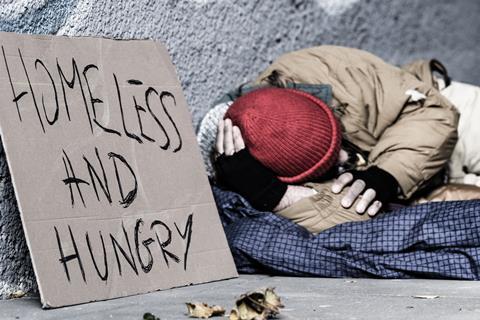Last autumn’s Budget and spending review were notable for many reasons, not least the significant increase in funding allocated by the government to tackle the current surge in rough sleeping and homelessness.

As significant as this may have appeared at the time, it is rapidly being dwarfed by the scale of the cost-of-living crisis now consuming the UK, with inflation at levels not seen since 1992. So, it will barely slow the growth in the rise in numbers of homeless people, let alone start to reverse the trend.
By the time the funding has been allocated to each local authority (LA) and deployed to provide additional support and accommodation, tens of thousands of people will have joined the list of the unintentionally homeless because of the soaring cost of living.
In assessing the scale of the challenge, we only have to look at the figures for the capital released by London councils last summer, which showed that there were more than 165,000 Londoners in temporary accommodation – more than the total population of Oxford or Norwich.
Particularly notable is that some 90,000 of these are children, and that number is steadily rising. This has been driven by a combination of the gradual unwinding of pandemic support measures, including the eviction ban, the social and economic consequence of Covid-19 and the rising cost of living. These include financial factors such as loss of income, right through to relationship breakdown and other health issues.
As identified within the Budget, this has led to significant pressure being placed not only on LAs, but on the housing sector in general and those charitable and voluntary organisations that do so much to assist.

Despite the promise made of extra funding, many say it will be nowhere near enough. London boroughs alone collectively spent more than £1.2bn on tackling homelessness in 2020. It seems unlikely these additional funds can really deliver the long-term solutions we all know are needed – more truly affordable rented, stable, long-term housing.
In fact, the delivery of significant new quantities of social housing at a scale to really start to tackle the huge numbers of people currently within temporary accommodation was barely mentioned by the government. Nor was the need to urgently build additional high-quality temporary accommodation to enable local housing authorities to fulfil their obligations without recourse to expensive and often scarce accommodation within the PRS.
Both are critical for any long-term solution to the homelessness crisis, given that in London alone we are edging close to exceeding the all-time high of people living in temporary accommodation achieved in 2005. Therefore, as the government starts to crystalise its thinking to deliver its levelling-up agenda, we believe measures to provide long-term solutions to tackle homelessness need to be central to this.
These measures must include enabling councils to significantly boost the number of new homes built either in partnership or as standalone developments. Greater financial support to LAs is essential, as well as reform to Right to Buy so councils can retain 100% of receipts, which would help them to secure and deliver much-needed new homes.
Josie Parsons is chief executive of Local Space





























No comments yet